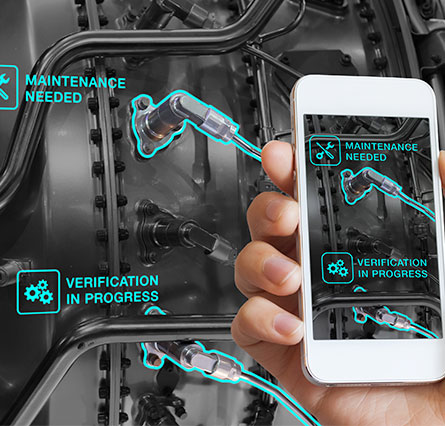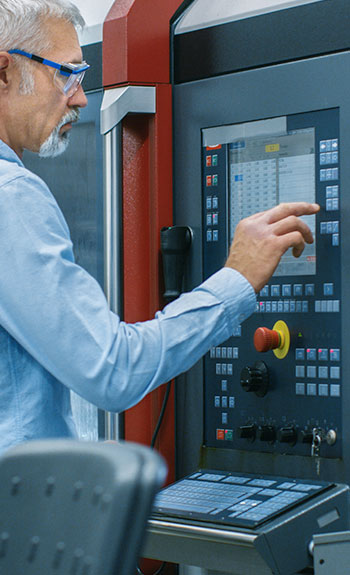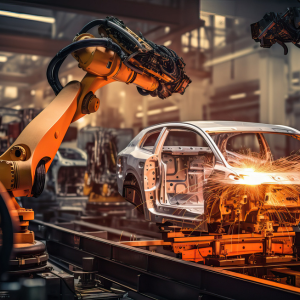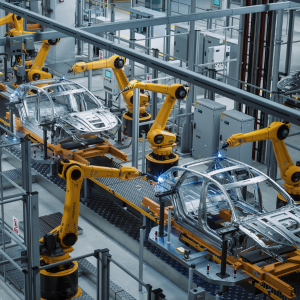Smart Maintenance Guide
Post By: Tom Rowse On: 29-10-2018 - Industry 4.0 - Industry Trends
As we move further into the automation age, the tentacles of technology are not only able to connect all the minutiae of our daily lives (the IoT, or Internet of Things) but also our working lives (the IIoT or Industrial IoT). From smart cars to smart cities, automated systems are not only doing the work, but are also beginning to master the capability for self-maintenance. The IIoT is part of the 21st century technological revolution, and systems managers need to be aware of how great an impact Smart Maintenance can have on production output and cost-savings. It is estimated that a saving of up to half a million pounds a year could be effected with Smart Maintenance, with an associated benefit of increased customer loyalty.
What is Smart Maintenance?
The IIoT is the visible face of the Fourth Industrial Revolution, or Industry 4.0. This is the information age, where everything gets connected and industry moves into a self-governing and self-maintaining era, leaving human beings to more creative and useful tasks. From the first mechanical steam-powered systems of the 1st Industrial Revolution, to electrically governed mass production (the 2nd), we have now progressed from computers and simple automation (the 3rd) into an integrated system of interconnected, data-driven, cyber-physical solutions (the 4th). These systems run on massive data input, and that input can be used to improve systems analysis, reduce costly downtime and predict potential failures before they happen.
Smart Maintenance relies on the comprehensive collection of data, and the capacity for remote monitoring to enable a constantly updated information stream, available at any time and in any place. This leads to guided predictive maintenance and optimised repair strategies. Machines with deep learning capacity not only analyse past and present performance, but can also offer valuable insights and diagnostics for machines and their components.

3 Key Features of Smart Maintenance
In order to introduce Smart Maintenance into your existing production or assembly line, there are three key features that you'll need to consider. These fall under the general headings of data generation, data collection and data analysis. Data can be generated in a variety of ways, mostly based on observing activity and monitoring performance. Wireless connections allow this data to be transferred to a remote collection point where it can then be analysed.
1. Data Generation: Sensors
Sensors are one of the most prolific and useful means of generating data. Many products these days are relatively inexpensive, and can contribute large quantities of data from various areas around the production floor and from inside the equipment itself. Such data can help to indicate potential system faults, together with environmental factors such as changes in temperature, liquid or gas leaks, excess vibration and a host of other information.
Sensors are the key to changing from a reactive maintenance strategy to a predictive maintenance strategy, by identifying problems and fixing them before they happen. Smart Maintenance is based on the information provided by the sensors you install, and the more precise and detailed the information these sensors provide, the more accurate an analysis they will supply as to the state of your production system.
Thermal Sensors
One of the simplest and most recognisable examples of a sensor is a thermometer, which determines the ambient temperature through the reaction of the mercury core. More complex thermal sensors for measuring operating temperatures of industrial machinery include semiconductor-based sensors, thermocouples and thermistors, which can be integrated into control systems to feed back any environmental temperature changes that might affect productivity. They can detect the precise moment when a machine or component begins to overheat, and be programmed to shut it down or employ other strategies to normalise its operating temperature.
Vibration Sensors
Vibration sensors are critical to the stability of sensitive equipment and to detecting excess vibration or speed in electric motors. The simplest vibration sensor is probably a gyroscope, but more sophisticated vibration sensors, also called piezoelectric sensors, can measure all sorts of delicate processes. The piezoelectric effect measures minute changes in temperature, acceleration, pressure, force or strain by transforming them into an electrical charge. A really sensitive vibration sensor can even be used to sense smells, by a simultaneous measurement of capacitance and resonance. This kind of sensor is used by engineers, nuclear technicians, vehicle designers and the medical industry.
Other Types of Sensor
Light beams are an increasingly common type of sensor in automated systems, and include infrared detection systems as well as photo-electric light or laser sensors. These are particularly useful for use in safety precautions, such as light fences or enclosures. You'll also find simple electrical sensors for detecting and stabilising fluctuations in current, water sensors for detecting excess moisture in pipes or AC units, pressure sensors that can record changes in air pressure or liquids, and ultrasonic sensors which identify high frequency emissions. All of these and more produce valuable information as to the state and performance of your system, which in the information-based Industry 4.0 environment is known collectively as Big Data.
2. Data Collection: Big Data
Big Data is being generated and collected on a vast scale, which only artificial intelligence can process satisfactorily. Even for individuals, the daily quantity of data that is collected via technology provides a substantial amount of personal information about your mind and body, which can be analysed by your own phone if you wish to focus on your personal performance.
Wearables
Data collection from wearable tech includes your health and fitness status, using information generated via apps that count your heartbeat, blood sugar levels, sleep hours and footsteps. If you don't wear a watch, data monitoring rings are the new wearable that is both discreet and disturbingly powerful in providing fitness and health data. All of this information allows a proactive, personal kind of maintenance driven by smart tech, so you can perform your own Smart Maintenance in your daily routines.
Mobiles
Amongst other sensitive information your mobile devices and laptops can collect is GPS data, following your movements and logging everywhere you go. Devices will collect details of your personal and professional communications network, and your internet browsing history, including your purchase and credit history, not to mention your social media presence. Apps will register every time you use a car service, order a pizza delivery, join a Meetup, check in for a flight, or book a hotel. More importantly for industry, they can also be used to monitor your production performance remotely.
Microchips
Slightly more disturbing in the post-apocalyptic, 1984 sense, are the NFC (Near Field Communication) and RFID (Radio Frequency Identification) technologies used in microchip implants. Already widespread in Sweden, those who can't be bothered with bar codes and chips on their bank cards have opted instead to have a data microchip implanted under their skin. This means that entering buildings, vehicles, lifts and restricted areas can all be reduced to a wave of the hand. It can even be used to obtain goods from vending and ticket machines. Some researchers are suggesting the chip may expand to include medical data as well as financial, which could introduce further streams of big data into an already active universe.

Health and Safety
Big Data is also collected from personal information generated by people in their working environment, measuring such things as their posture, air supply, tiredness, and productivity levels, as well as the basics of hours worked and personnel data. At the same time, big data functions as an indicator of how efficiently safety barriers are working, and whether automated sensors are helping to reduce the incidence of work-related accidents. Introducing more sophisticated sensors and predictive maintenance techniques will contribute to a reduction in the risks of both machine failure and human injury.
Industry
On an industrial scale this huge data stream expands exponentially to include global performance information on particular machine models and components, energy consumption, environmental operating efficiencies, and maintenance interventions. The many data-collecting sensors which transmit information for analysis to a computerised maintenance management system are, in some cases, already contributing to global databases. These libraries of accessible information increase our overall fund of knowledge on particular items and systems. As automated functions proliferate and the number and capacity of components becomes more complex, such data libraries provide a valuable resource for designing more reliable and self-maintaining systems.
3. Data Analysis
The major change that is occurring with Industry 4.0 is that this information is being processed by intelligent machines. Only Artificial Intelligence has the capacity to deal with the sheer volume of Big Data, and the ability to process and then learn from it at a rate unmatchable by human skills. Big Data analytics allow for much faster processing of a lot more information, and deep learning enables AI to make deductions and even predictions. These can then be fed directly into controllers to make necessary alterations to a system, in a fraction of the time it would take for a human response. This means that overall response times become more rapid, machine downtime is greatly reduced and the equipment's whole life-cycle is prolonged.
Smart Maintenance systems call on powerful software analytics that can deliver results in real time, turning even reactive maintenance into a much faster process. Integrated communication technologies also mean that systems managers can access this data remotely at any time, and on any type of smart device, detecting and communicating problem information immediately to personnel on the ground.
How Smart Maintenance Will Change Industries
In order to make the best use of Smart Maintenance techniques, it's important to assess the areas in which these techniques could make a difference. Each stage of the production process should be examined to discover when and why existing maintenance tasks are being carried out, and whether these decisions are based in logic or habitual practice. Age-old traditions need to be questioned, so that technological resources can be used strategically rather than fixing things by guesswork and time-honoured procedures.
Key Performance Indicators
The best way to do this is to assess production performance through Key Performance Indicators (KPIs). If you break down each phase of production and the specific maintenance tasks that are being performed, you’ll be able to identify existing inefficiencies, and deduce which data needs to be tracked to optimise efficiency.
KPIs to look at include:
- Building and room occupancy levels
- Geographical differences in energy consumption and costs
- Air and water management
- Personnel comfort and safety levels
- Work orders (scheduled, completed, overdue and time spent per job)
- Machine functionality (uptime vs. downtime)
- Ratio of reactive maintenance to scheduled maintenance tasks

Combining the information you gather from the KPIs with historical maintenance data forms the base on which you can build new data streams from sensors and data libraries. Information provided by manufacturers and users of the same systems and equipment are valuable in establishing a recommended maintenance cycle, but a portfolio of sensors will add to this a constant data stream of real-time information. This will encourage a move from fixed maintenance based on calendar points, to adaptive maintenance based on performance.
Once you have all this information, you'll need a good program for data analysis that has inbuilt machine learning, which will then allow the processing of the big data to produce predictions of likely machine weakness or failure. As the parts and the machines themselves are both monitored individually, the data isn't averaged from the performance of other machines or standard supplier specifications. Using the conclusions produced by such big data analytics, you can then programme your system for predictive maintenance.
Conclusion
The adoption of IIoT changes the approach of maintenance interventions from reactive to proactive, creating ongoing predictive and preventive maintenance routines. A Smart Maintenance system is able to collect and process big data, provide performance and behavioural insights, anticipate abnormal situations, set off warning alarms and supply instructions for pre-emptive maintenance. Machines are now capable of making their own decisions and providing necessary technical assistance, without human intervention, which leads to a more transparent and rapid exchange of information. Smart maintenance also promotes minimised energy consumption and thus environmentally efficient production. In essence, big data can increase the overall performance and reliability of the system with significant cost savings.
Get More From Rowse Straight To Your Inbox




